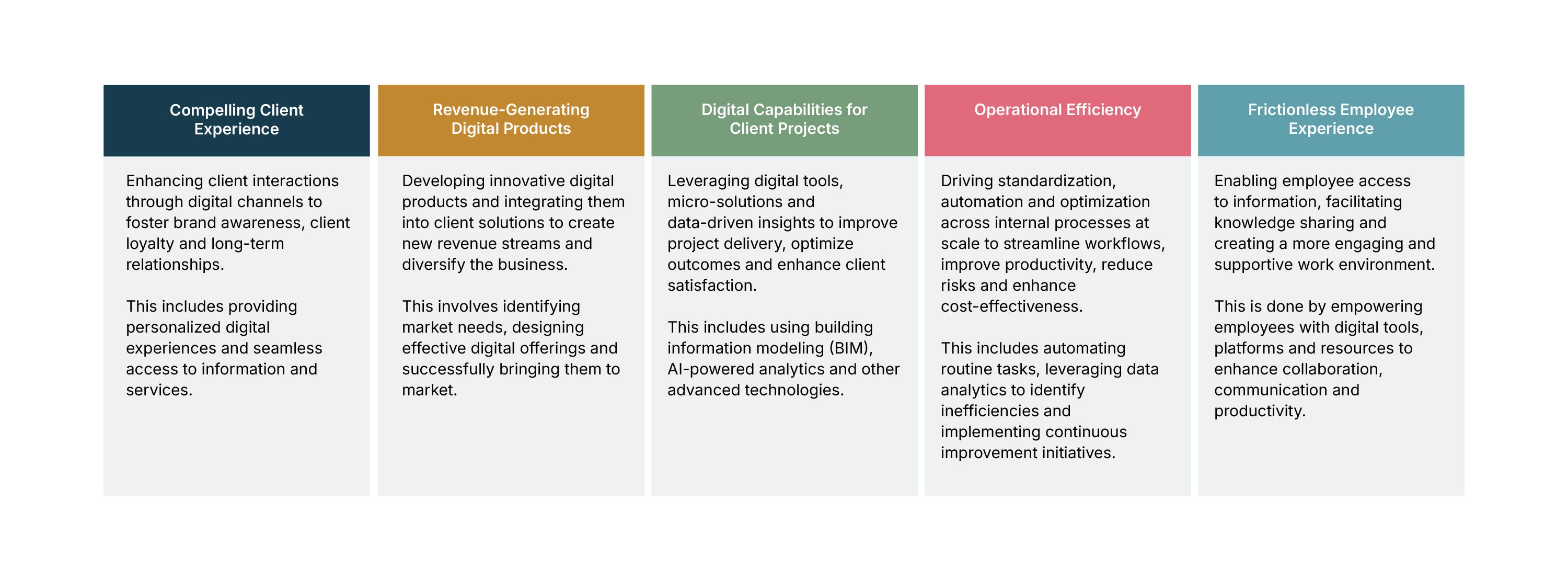Digital transformation is rapidly reshaping the Architecture, Engineering, and Construction (AEC) industry, and Arcadis is at the forefront of this revolution. By embedding cutting-edge technologies like citizen development, data analytics and artificial intelligence into its digital strategy, Arcadis is not just adapting to change but driving it. This refreshed approach unlocks new ways to create value, tackle complex challenges and innovate on a global scale. Discover how Arcadis is bridging the gap between innovation and practical impact, and paving the way for a more efficient and connected AEC industry.
Professional services in the AEC industry
Arcadis is a leading global design and consultancy organization for natural and built assets, providing professional services in close collaboration with its clients. Operating in the AEC industry, it helps clients from various sectors to plan, build and operate assets, such as habitats and workplaces, mobility and energy infrastructure. Rapid technological advancements and increasingly complex client needs mean that tech-powered differentiation has become essential in the AEC industry. This evolution involves embedding advanced technologies like data analytics and artificial intelligence (AI) into routine professional services. By doing so, Arcadis can deliver innovative, future-ready solutions that meet the continuously changing demands of its clients
Various technologies are already foundational elements of AEC projects. In recent years, the digital transformation of the AEC industries has unlocked productivity gains through technologies including building information modeling (BIM) and design automation. Digitalization of the design and building process has also led to vast amounts of data. Unlocking the potential of this data promises a huge opportunity for organizations to improve efficiency and even offer new services.
In an AEC professional services organization, the value creation through digital technology is spread across various organizational units. Every client project, for example the design of a railroad bridge, the construction of a wind park, or the planning of new urban development, may require not only the use of digital tools but also the creation of new digital assets like data analytics dashboards, automations or interfaces to client IT systems. Therefore every client project is a possible incubator for micro client-specific innovation.
How digital creates value
Among other aspects, a digital strategy guides how an organization creates value with digital and prioritizes the components in the business to invest in and accelerate digital maturity. A key component of Arcadis’ digital strategy are its value levers, the areas in which Arcadis mines value in its business through digital means. Inspired by “The New Elements of Digital Transformation” the value levers are shaped in the following form:


These value levers are closely aligned with Arcadis' corporate strategy and are essential for achieving key business objectives. Based on the value levers the digital strategy defines priorities for further initiatives and investments in digital.
Challenges and ambitions
Strategies focus on systemic challenges to overcome. Market needs are driving the digital transformation journeys of global professional services organizations, which are encountering a number of challenges.
- Project work must be centered around client-specific problems. Therefore project teams must have a high degree of autonomy to create client-specific solutions. These requirements hinder the efficient global scaling of digital solutions.
- High autonomy of project teams leads to a decentralization of decision making. But digitalization comes with a higher risk profile that requires strong governance. The danger is that strong governance will undermine the autonomy of project teams and hence lead to lower client satisfaction.
- Many professional services organizations are striving to create new revenue streams with digital products. Yet investing in products needs a different operating model than running a professional services business. Doing both requires leadership attention and support for both sides of the business model.
- In order to deliver client value, digital capabilities are spread across the organization. This necessitates developing employee capabilities globally, while also providing a central space to foster synergies and grow knowledge.
These challenges may appear contradictionary, creating a dilemma for continued digital growth. A successful digital strategy must respond by developing a coherent set of policies and actions that embrace – rather than avoid – these contradictions.
Arcadis had already addressed these contradictions in the specific technological field of citizen development. Arcadis is embracing citizen development through a central strategy led by the tech department, empowering non-technical employees to create digital solutions using low-code/no-code platforms. This approach democratizes technology development and enables faster innovation. This aligns with the concepts discussed in "All Hands on Tech", which highlights the benefits of empowering non-IT employees to contribute to digital innovation.
Digital blurs the boundaries between tech and business
New technologies like data platforms and genAI are providing even more opportunities to bring digital closer to the business. In fact, the boundaries between tech departments and business departments are becoming increasingly blurred. New technologies and platforms enable non-technical people to use digital in more creative ways. At the same time, digital solutioning gets closer to the domain problems. Similar to the data mesh approach, where data products are owned by domain experts, new AI platforms and LLMs will make data analytics and process automation even more accessible for non-technical team members.
Consequently the current trends of citizen development, data and AI require a digital strategy that embraces the contradictions outlined above. The digital strategy will pave the way for future tech trends where digital grows beyond tech departments and gets closer to the problems it’s solving. This will also reduce hand-over waste and speed up time-to-market, with improved quality and outcomes for the business.
.jpg)
.jpg)
Ecosystem approach
When technological opportunities and user needs come together, they are forces for innovation and growth. Instead of containing the forces, digital leadership should focus on unleashing them to nurture the creativity sparked by new technologies. Digital inside an organization should grow like an ecosystem beyond tech departments.
Arcadis is adopting this digital ecosystem approach, which views digital initiatives not as isolated projects but as interconnected components of a larger, integrated system. This approach fits well with the nature of work in the AEC industry.
The ecosystem is populated by inhabitants, e.g. digital solutions, software products and platforms with associated teams and data. They enjoy a certain degree of freedom - aligned autonomy based on shared principles. Among others, the principles support interoperability, reuse, fast flow and risk awareness. The ecosystem is built on three fundamental pillars:
- Enablement: Providing employees with the necessary tools, training and resources to effectively participate in the digital transformation.
- Self-service: Offering user-friendly platforms, tools and resources that empower employees to access information, solve problems and create value independently.
- Governance: Establishing clear guardrails, standards and frameworks to maintain order, security, compliance and alignment across the ecosystem.
The pillars give the organization guidance to shape the environment of the inhabitants so they can flourish. Every type of inhabitant deserves appropriate enablement activities, valuable self-service platforms, and requires a governance model that sets guardrails. Using self-service platforms, the central tech department has the lever to shape the ecosystem with the right level of governance.
Technology is increasingly becoming the centerpiece of modern business. Tech at core differentiates brands but also enhances the value delivered to customers. But achieving this requires adopting modern socio-technical approaches that align people, processes and platforms across the enterprise. This ecosystem is designed to be compatible with emerging technological paradigms. It provides a unifying framework that fosters a culture of continuous digital transformation.
The following trends exemplify how this ecosystem approach can be applied:
- Citizen development: The ecosystem not only provides the tools but also the necessary enablement and critical governance to contain risks.
- Data mesh: Enablement of federated data ownership and a self-service data platform with governance are foundational principals that are compatible with the ecosystem approach.
- Product-led operating model: Aligned autonomy is an important principle of the ecosystem and product organizations, and ecosystem members (inhabitants) are the leading element to compose a product portfolio for investment.
- Composable architectures and platforms: The ecosystem's emphasis on interoperability and reuse fits well with composable architectures.
- Agentic AI: The ecosystem can provide a platform for AI agents, with clear guardrails and standards established by the governance pillar. It also provides the enablement for sufficient AI literacy.
The ecosystem approach inside the digital strategy provides the narrative to embed further tech trends in the operating model, and grow digital capabilities alongside new technological advancements.
Ecosystem evolution
The strategy is not static, but evolutionary in nature. Since digital technologies continue to develop and disrupt the markets, a digital strategy should embrace this dynamic. New trends like genAI bring new opportunities. Adopting the new technologies is a necessity, but should be done in a coordinated way.
Arcadis’ digital strategy introduces the concepts of digital catalysts, new technologies that are adopted in the organization and evolve the ecosystem - may require new skills, new infrastructure and platforms, and an improved governance model. Regular scanning of the environment, client projects and innovation initiatives lead to the discovery of new catalysts - opportunities to advance. Adoption of catalysts is shaped by integral strategies that evaluate the opportunities, investments and changes necessary to grow the three fundamental pillars of the ecosystem - enablement, self-service and governance.
Conclusion
Arcadis' renewed digital strategy represents a significant step towards becoming a technology-led organization. By focusing on key value levers, addressing challenges and embracing an ecosystem approach, Arcadis is well-positioned to meet the evolving demands of the AEC industry and achieve its strategic goals.
References
The New Elements of Digital Transformation; Didier Bonnet, George Westerman; MITSloan Management Review, Vol. 62, No. 2; https://mitsmr.com/2UEVUzY
All Hands on Tech: The AI-Powered Citizen Revolution; Thomas H. Davenport, Ian Barkin, Chase Davenport (With); John Wiley & Sons, Inc. 2024
Data Mesh: Delivering Data-Driven Value at Scale; Zhamak Dehghani; O'Reilly Media, Inc. 2022


















